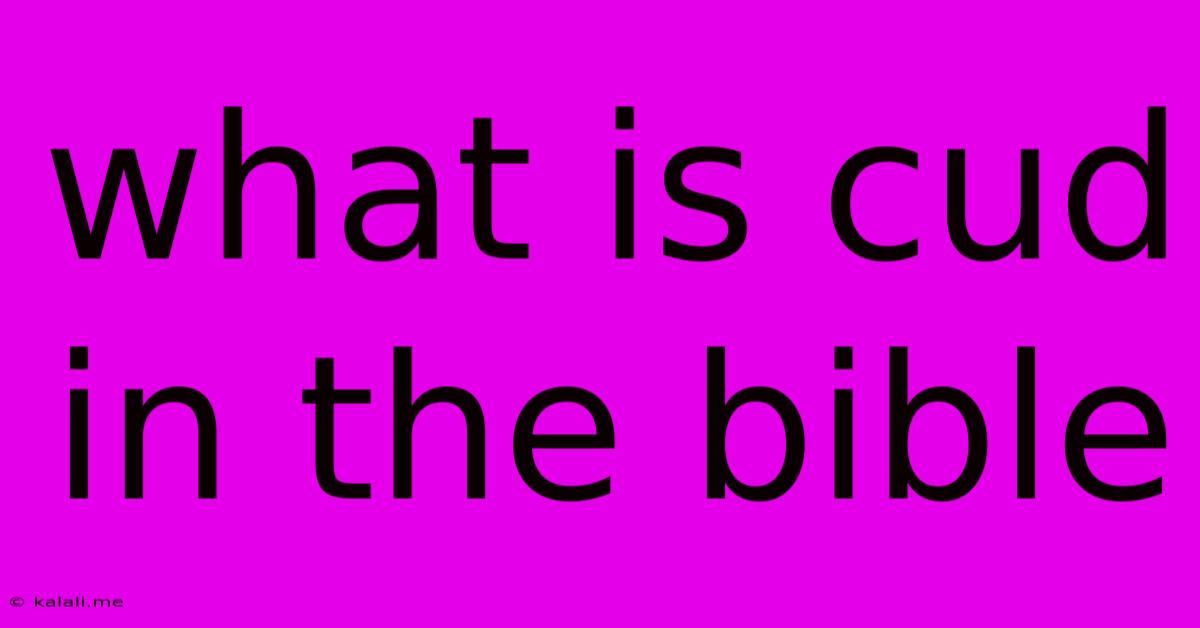What Is Cud In The Bible
Kalali
Jun 01, 2025 · 3 min read

Table of Contents
What is Cud in the Bible? Understanding Clean and Unclean Animals
The concept of "cud" in the Bible is deeply intertwined with the laws of kashrut, the Jewish dietary laws. Understanding what cud is, and which animals chew it, is key to grasping this ancient system of clean and unclean animals. This article will explore the biblical definition of cud, its significance, and its lasting impact on religious and cultural practices.
What is Cud?
Cud is the partially digested food that ruminant animals regurgitate from their stomachs to chew again. This process, known as rumination, is a characteristic feature of animals with a four-chambered stomach, such as cows, sheep, goats, and deer. These animals initially swallow their food quickly, and then later bring it back up to their mouth for more thorough chewing before it finally goes down for digestion. The Bible uses the act of chewing cud as a crucial element in determining which animals are considered "clean" and suitable for consumption.
Biblical Significance of Cud Chewing Animals
The Book of Leviticus (Chapter 11) outlines the rules concerning clean and unclean animals. It states that a clean animal must be both a cud-chewer and have cloven hooves. This seemingly simple criterion carries significant weight in Jewish tradition and has ramifications extending beyond dietary laws.
The specific wording in Leviticus is crucial: an animal must possess both characteristics to be considered clean. An animal that chews cud but does not have cloven hooves, or vice versa, is deemed unclean and forbidden for consumption. This dual requirement acts as a double check, ensuring a stricter definition of clean animals.
Examples of Clean Animals (Cud Chewers with Cloven Hooves):
- Cows: A quintessential example of a clean animal, widely used in ancient agriculture and often mentioned in biblical contexts.
- Sheep: Another common domesticated animal frequently referenced in the Bible, serving as a source of food and sacrifice.
- Goats: Similar to sheep in their use and significance within ancient Israelite society.
- Deer: While less common as a domesticated animal, deer are explicitly mentioned as clean animals.
Examples of Unclean Animals (Lacking One or Both Characteristics):
- Pigs: Pigs possess cloven hooves but do not chew their cud.
- Camels: Camels chew their cud but do not have cloven hooves.
- Rabbits: Rabbits chew their cud, but their hooves are not cloven. (Note: The classification of rabbits' chewing behavior as "cud-chewing" is debated among modern zoologists; the biblical classification is based on ancient understanding).
Beyond Dietary Laws: The Symbolism of Cud
The significance of cud in the Bible extends beyond dietary regulations. The process of rumination, the thorough and repeated chewing of the cud, can be seen as a metaphor for reflection, contemplation, and the thorough processing of information. This symbolic interpretation adds layers of meaning to the verses in Leviticus. It suggests a deeper spiritual principle: a commitment to careful consideration and thorough understanding.
Conclusion:
The biblical concept of cud is not merely a list of permissible foods. It's a key element within a comprehensive system of laws designed to shape the lives and practices of the ancient Israelites. Its significance lies not only in its practical application to dietary laws but also in the symbolic meaning it carries, offering a rich tapestry of religious and cultural insights. The continued study of these ancient texts provides valuable historical context and encourages deeper reflection on the values and beliefs they represent.
Latest Posts
Latest Posts
-
15 Amp Gfci On 20 Amp Circuit
Jun 03, 2025
-
What Temp Is Medium High Heat
Jun 03, 2025
-
Pros And Cons Of Dual Home Air Conditioners
Jun 03, 2025
-
How Much Prime Rib Roast Per Person
Jun 03, 2025
-
Is A Definite Integral Always Positive
Jun 03, 2025
Related Post
Thank you for visiting our website which covers about What Is Cud In The Bible . We hope the information provided has been useful to you. Feel free to contact us if you have any questions or need further assistance. See you next time and don't miss to bookmark.